7 Best Tools to Help You Write Your Self Review in 2025
Staring at a blank self-review form? These AI-powered tools and templates help you remember your accomplishments and write compelling performance reviews in minutes, not hours.
You open your inbox: “Annual Performance Reviews Due in Two Weeks.” A blank form stares back, asking you to recall months of accomplishments, challenges, and goals.
Writing a self-review feels overwhelming. Your mind goes blank. What projects did you ship in Q2? What was that client win in July? Did priorities shift from your original goals?
The good news? AI-powered tools and smart templates can help you organize thoughts, remember wins, and craft a compelling self-review that reflects your value.
Here are the seven best tools to help you write your self-review in 2025.
1. Windmill Self Review Tool
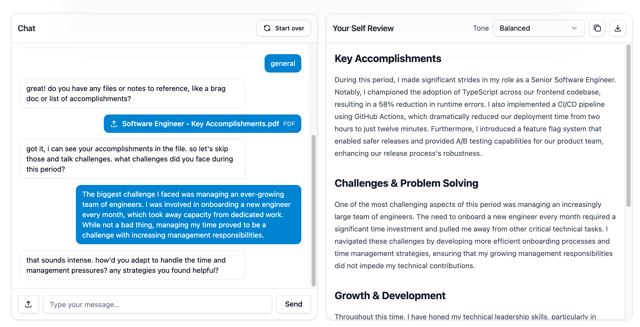
Best for: Purpose-built, conversational AI for performance reviews
Price: Free (no signup required)
Key features
- Conversational chat interface designed for self-reviews
- Upload your brag doc (CSV, PDF, or TXT) and chat naturally
- AI asks informed follow-up questions
- Choose your tone: balanced, confident, growth-oriented, or analytical
- Upload company-specific review questions or use generic format
- 100% free with no data storage—everything happens in your browser
Windmill’s Self Review Tool is built specifically for self-reviews. Upload your brag doc, then have a natural conversation about your accomplishments.
The chat interface asks clarifying questions, helps you quantify impact, and guides you through structuring thoughts into a coherent narrative. It’s like having a career coach in your pocket.
Completely free, no signup required, and doesn’t store your data.
Ideal for: Employees with loose notes or a brag doc who want an intelligent conversation to create a polished self-review.
2. Notion Brag Doc Templates
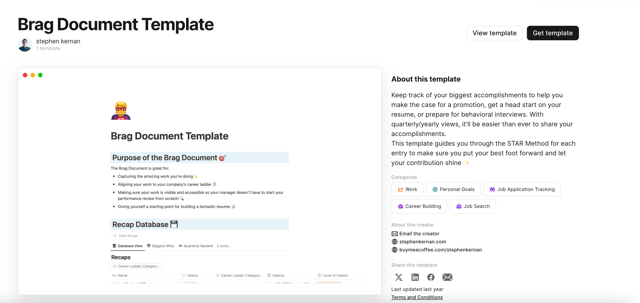
Best for: Proactive tracking throughout the year
Price: Free with Notion account
Key features
- Pre-built templates for tracking wins, projects, and feedback
- Organized database structure
- Integration with existing Notion workspace
- Customizable categories and tags
The secret top performers know: write your self-review continuously, not all at once.
Notion’s Brag Doc templates, popularized by Julia Evans, let you document accomplishments as they happen. Free templates typically include sections for:
- Projects completed
- Goals achieved
- Positive feedback received
- Challenges overcome
- Skills developed
When review time arrives, you have a comprehensive document ready. Use this with Windmill’s Self Review Tool to generate your final review.
Ideal for: Organized individuals who track accomplishments in real-time.
3. ChatGPT
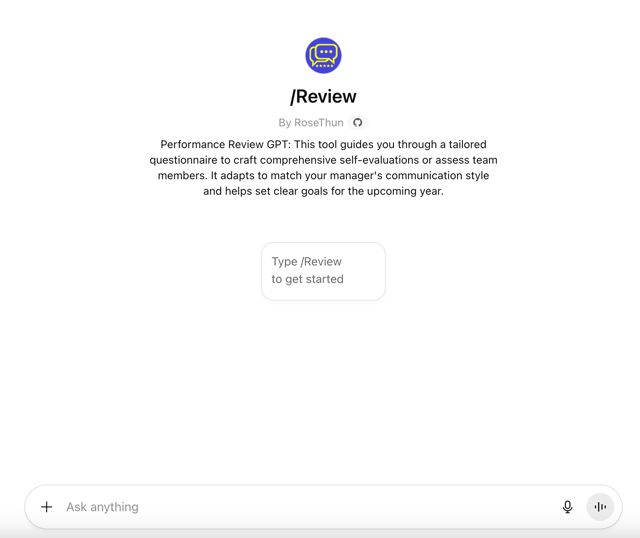
Best for: Versatile AI assistance
Price: Free tier available; ChatGPT Plus at $20/month
Key features
- Powerful language model for drafting and refining text
- Helps structure thoughts and improve clarity
- Rewrites bullet points into narrative form
- Adjusts tone based on company culture
ChatGPT is the Swiss Army knife of AI tools. The key is effective prompting.
Instead of “write my self-review,” use it as a writing partner:
- Give accomplishments and ask it to quantify impact
- Share rough drafts for clarity improvements
- Request STAR method framing (Situation, Task, Action, Result)
- Ask for different phrasings to balance confidence and humility
The downside? It’s general-purpose, not designed for performance reviews. It won’t guide you through the process like dedicated tools.
Ideal for: People comfortable with AI who want flexibility.
4. ClickUp Performance Review Templates
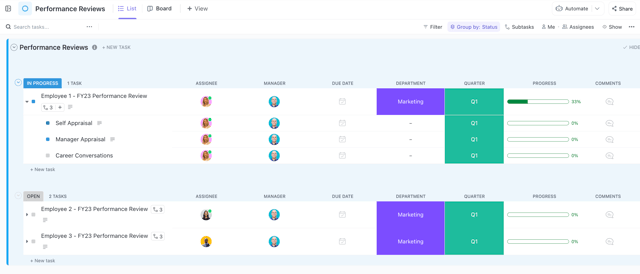
Best for: Teams using ClickUp for project management
Price: Free tier available; paid plans from $7/user/month
Key features
- Pre-built performance review templates
- Integration with ClickUp tasks and projects
- Automatic tracking of completed work
- Customizable review criteria
If your team uses ClickUp, all your completed work is already documented.
ClickUp’s Performance Review Templates help you leverage this data. Templates provide structured frameworks integrated with your workspace, making it easy to reference specific tasks, projects, and accomplishments.
AI-powered features surface relevant accomplishments you might have forgotten, pulling from activity history to remind you of contributions and milestones.
Ideal for: ClickUp users who want to leverage existing project data.
5. Lattice
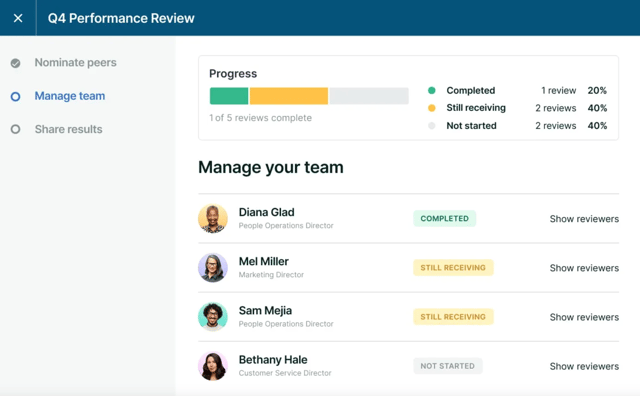
Best for: Companies with comprehensive performance management systems
Price: Enterprise pricing (contact for quote)
Key features
- Full performance management platform
- AI writing assistance for reviews
- Continuous feedback tracking
- Integration with HRIS systems
- 360-degree review capabilities
If your company uses Lattice, you’re in a comprehensive performance management ecosystem. AI-powered writing assistance helps employees craft self-reviews by:
- Suggesting language improvements
- Helping quantify achievements
- Ensuring alignment with company values
- Maintaining consistent tone
The platform’s power comes from continuous feedback tracking. Throughout the year, managers and peers leave feedback that automatically feeds into your self-review with concrete examples.
Lattice is an enterprise solution your company adopts organization-wide—not something you sign up for individually.
Ideal for: Employees at companies that have implemented Lattice.
6. Easy-Peasy.AI Performance Review Generator
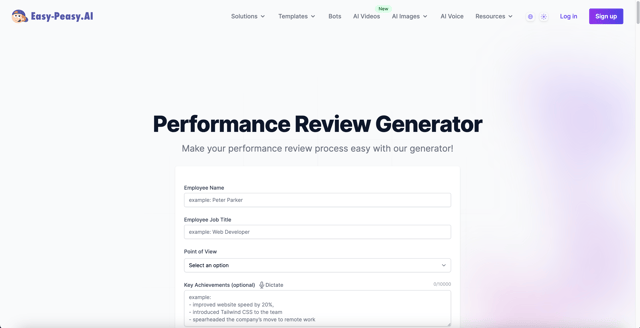
Best for: Quick, template-based generation
Price: Free tier available; paid plans from $5.99/month
Key features
- Dedicated performance review templates
- Multiple review types (self, peer, manager)
- Form-based input for accomplishments
- Quick generation of review text
Cons
- No ability to upload supporting documents
- No ability to modify questions or review sections
Easy-Peasy.AI offers a straightforward, form-based approach. Fill in fields about your role, accomplishments, areas for improvement, and goals. AI generates review text.
It’s faster than writing from scratch, but output can feel generic. Templates and standard phrasing might not capture your unique voice or specific contributions.
Useful for quick first drafts, but expect significant editing. For more conversational approaches, specialized self-review tools offer better contextual understanding.
Ideal for: People who want quick first drafts and plan to edit substantially.
7. Venngage AI Performance Review Generator
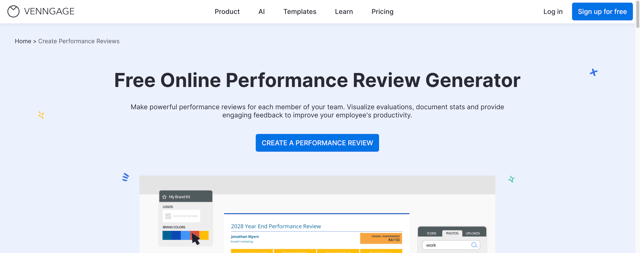
Best for: Visual learners who want formatted output
Price: Free tier available; paid plans from $19/month
Key features
- AI-powered review generation
- Visual formatting and design templates
- Export to various formats
- Focus on data-backed reviews
Venngage brings design expertise to performance reviews, offering AI-generated content with visual formatting. Creates reviews that are well-written and visually structured for easy reading.
Like Easy-Peasy.AI, it uses a form-based approach. You input performance information, and AI generates review content. The differentiator is visual output—export as formatted documents with clean layouts and visual hierarchy.
The limitation: form-based tools can’t have conversations about your work like chat-based tools. You’re limited to what you remember in input fields. AI can’t ask follow-up questions to surface additional accomplishments.
Ideal for: Those who value visual presentation and want aesthetically appealing self-reviews.
How to choose the right tool
If your company uses a performance platform (like Lattice), start there for integrated feedback and alignment.
If you’ve been tracking accomplishments in Notion or another system, upload your brag doc to Windmill’s Self Review Tool for a conversational experience.
If you’re starting from scratch, use a dedicated tool like Windmill’s that guides you through the process conversationally.
If you’re comfortable with AI, ChatGPT can be a powerful writing partner—just be prepared to craft effective prompts.
If your team uses ClickUp, leverage Performance Review Templates to pull data from existing work tracking.
Tips for writing great self-reviews
Be specific and quantify impact
Don’t write: “Improved team communication” Do write: “Implemented weekly standups that reduced project delays by 30%”
Numbers make accomplishments tangible.
Use the STAR method
- Situation: What was the context or challenge?
- Task: What needed to be accomplished?
- Action: What did you specifically do?
- Result: What was the outcome or impact?
This ensures you demonstrate impact, not just activities.
Tell a story
Show your growth over the review period. Did you develop new skills? Take on additional responsibilities? Help your team through challenges?
Balance confidence with humility
Celebrate wins, but show self-awareness by acknowledging growth areas.
Align with company goals
Reference your company’s mission, values, and strategic priorities. Show how your work contributed to broader organizational goals.
Keep evidence year-round
Track continuously:
- Projects completed
- Positive feedback received
- Problems solved
- Skills learned
- Goals achieved
Tools like Notion Brag Docs make this easy.
The future of self-reviews
Research shows 80% of employees prefer ongoing feedback over annual reviews, and organizations using AI significantly outperform those that don’t.
The shift toward AI-assisted review writing removes friction. When you’re not struggling to remember what you did months ago, you can focus on honest reflection and meaningful conversations about development.
Pick a system that works for you and stick with it. The best tool is the one you’ll actually use—both during review season and throughout the year.
Ready to write your self-review?
Try Windmill’s free Self Review Tool to turn your accomplishments into a compelling self-review in minutes. No signup required.
Your work matters, your contributions have impact, and with the right tools, you can articulate that value clearly and confidently.